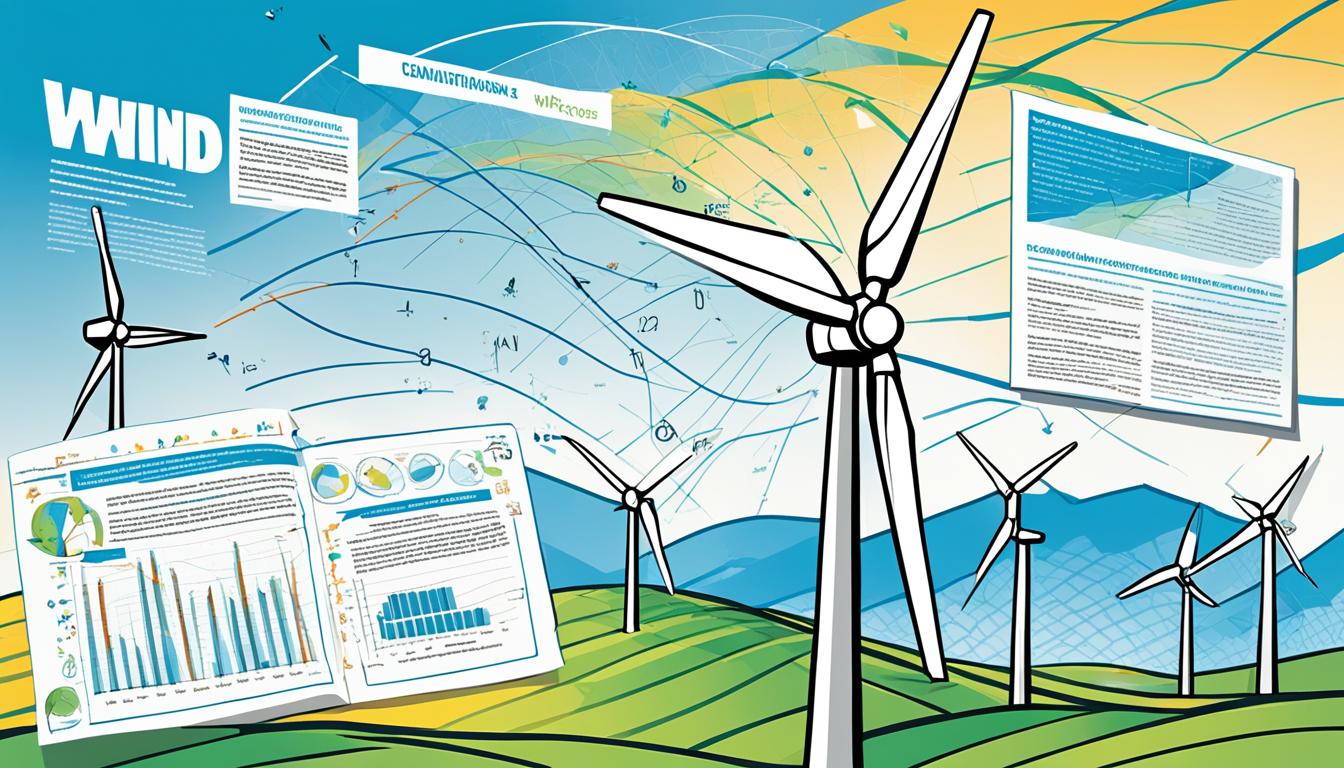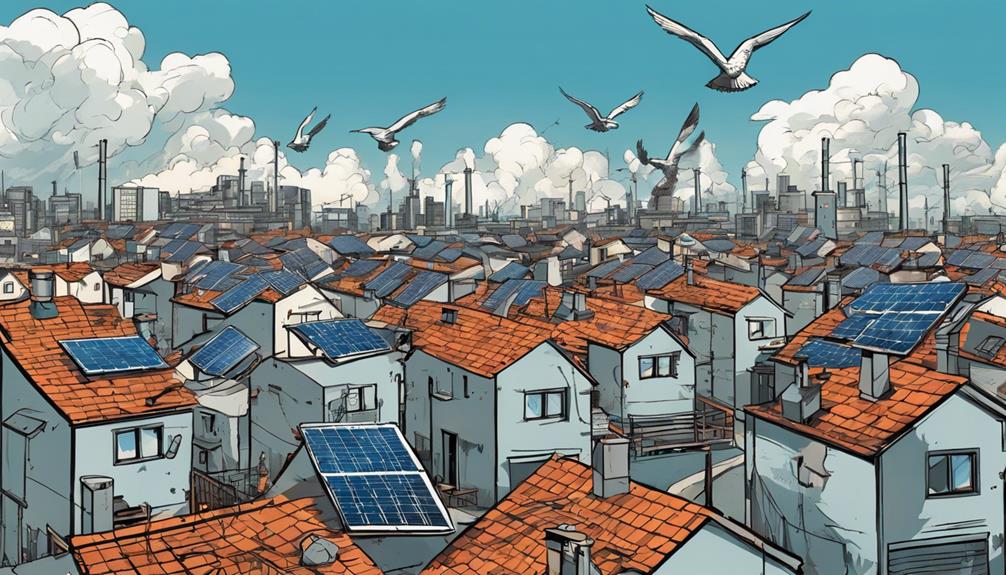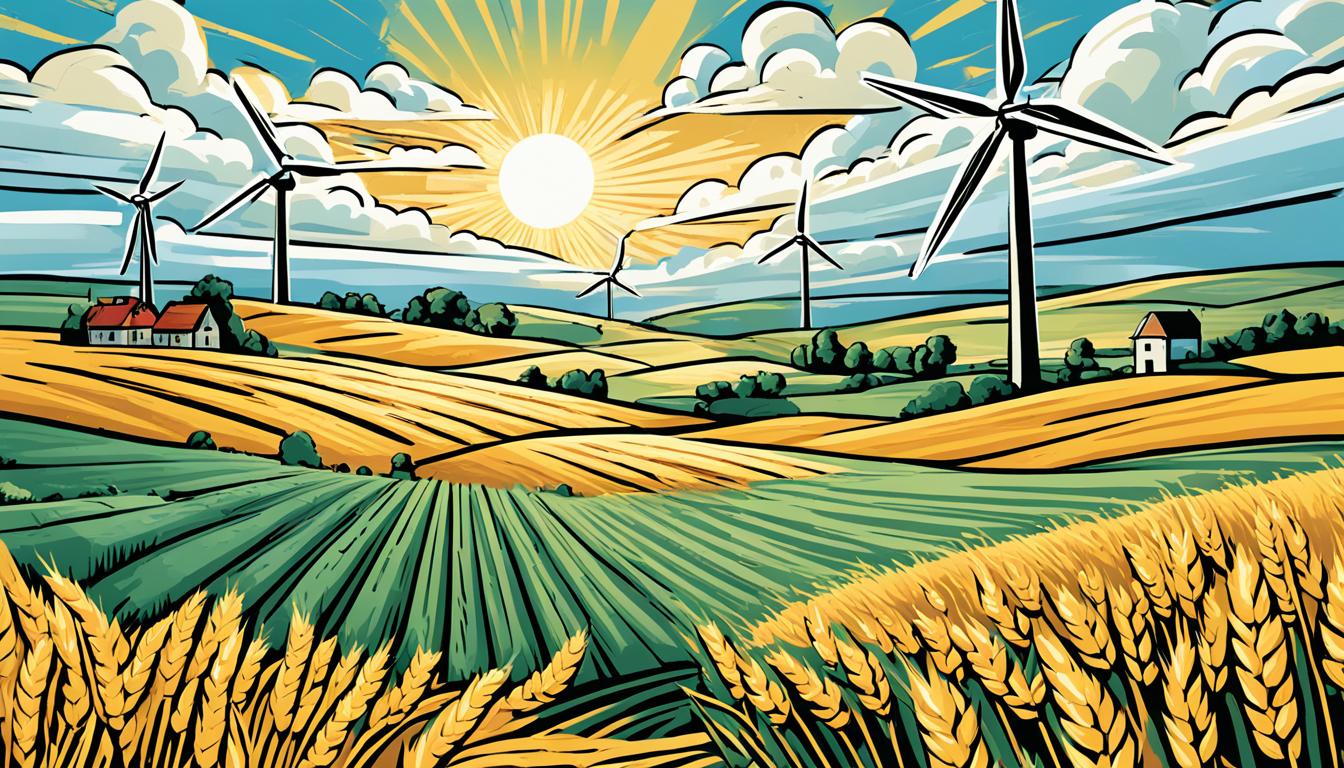Did you know that the power output of wind turbine systems is highly dependent on turbine size and the relationship between wind speed and energy content is an exponential one, with energy content increasing with the cube of the average wind speed1? These surprising statistics highlight the importance of selecting the right wind turbine or generator for optimal energy generation and sustainable power production.
When it comes to harnessing the potential of wind power, choosing between a wind turbine and a generator is a critical decision that directly impacts the efficiency and effectiveness of a wind energy system. Factors such as the type and design of the wind turbine, as well as the robustness of the generator, play a vital role in maximizing power generation and ensuring long-term sustainability.
Key Takeaways:
- The power output of wind turbine systems is highly dependent on turbine size and wind speed.
- Choosing the right wind turbine or generator is crucial for optimal energy generation.
- The relationship between wind speed and energy content is exponential, with energy content increasing with the cube of the average wind speed.
Types of Wind Turbines: Shaft and Blades
When it comes to wind turbines, there are two main types based on the orientation of their shaft and blades: horizontal axis wind turbines and vertical axis wind turbines. Let’s explore the characteristics and features of each.
Horizontal Axis Wind Turbines
Horizontal axis wind turbines (HAWTs) have an axis parallel to the ground, and they are the most prevalent type used in wind farms. Known for their efficiency, HAWTs typically feature three blades that resemble propeller airplane engines. These turbines can reach impressive heights equivalent to 20-story buildings and have blades longer than 100 feet. HAWTs are capable of generating significant amounts of electricity, with the largest operating turbines having an electric-generating capacity of approximately 15,000 kilowatts (15 megawatts). Some larger turbines are currently in development to surpass this capacity. Wind farms, which are collections of multiple wind turbines, play a crucial role in generating substantial electricity for electric-power grids.
Vertical Axis Wind Turbines
Vertical axis wind turbines (VAWTs) have a perpendicular axis, allowing them to harness wind power from different directions. This feature provides ease in wind power generation without requiring significant vertical height. VAWTs can be further classified into different designs, including Savonius, Darrieus, mixed turbine, and giromill. The Darrieus wind turbine design, patented in 1931 by the French engineer Georges Darrieus, features blades attached both at the top and the bottom of a vertical rotor. This design is reminiscent of a two-bladed eggbeater. Although VAWTs are compact and versatile, suitable for limited-space environments like urban areas, they are generally considered to be less efficient compared to HAWTs. However, with ongoing technological advancements and innovative designs, such as bladeless wind turbines, VAWTs are becoming more efficient and are being explored to improve energy generation and address visual and acoustic impact concerns.
Comparison of Wind Turbines
| Type | Design | Blade Configuration | Efficiency |
|---|---|---|---|
| Horizontal Axis Wind Turbines | Axis parallel to the ground | Three blades, similar to propeller airplane engines | Considered efficient |
| Vertical Axis Wind Turbines | Axis perpendicular to the ground | Blade configurations vary based on design (Savonius, Darrieus, mixed turbine, giromill, etc.) | Generally less efficient, but ongoing advancements in design are improving efficiency |
By understanding the differences between horizontal axis and vertical axis wind turbines, we can appreciate the strengths and potential of each design. The choice of which type to use depends on various factors such as location, space availability, efficiency requirements, and specific project goals.
“Wind turbines harness the power of the wind, and understanding their different types allows us to maximize their potential and contribute to a greener and sustainable future.”2
Types of Wind Turbines: Robustness
Wind turbines are classified not only by their design and functionality but also by their robustness, particularly in relation to wind speeds and challenging environmental conditions. One important classification system for wind turbines is provided by the International Electrotechnical Commission (IEC) 61400 standard, which considers turbulence intensity and maximum wind speed when categorizing wind turbines5.
Choosing a wind turbine that can withstand the wind speeds experienced at specific locations, especially in offshore wind farms, is essential for ensuring their longevity and sustainability. The robustness of wind turbines is particularly crucial in offshore installations due to the extreme conditions they encounter, such as high wind speeds and turbulent airflow, which can exert substantial stress on the turbines5.
The IEC 61400 standard provides guidelines for determining the appropriate wind turbine based on factors such as turbulence intensity and maximum wind speed. These factors help ensure that wind turbines are adequately designed to withstand the harsh conditions associated with specific locations and wind speeds5.
Manufacturers have been focusing on improving the robustness of wind turbines to enhance their performance, durability, and system stability during transmission network faults. One key aspect of wind turbine robustness is the ability to handle fluctuations in wind speed and maintain stable operation5.
Enhanced low-voltage ride-through capabilities are becoming a standard feature in wind turbines to improve the overall electrical robustness, especially in fault scenarios on the transmission system. These features enable wind turbines to remain connected to the grid and continue operation even during faults, ensuring a reliable and stable power supply5.
In addition to electrical robustness, wind turbines of the future are expected to have enhanced capabilities for smoothing output fluctuations. This helps minimize disruptions to the grid caused by the intermittent nature of wind power and enables wind turbines to participate more effectively in Automatic Generation Control (AGC)5.
Types of Wind Turbine Technologies
Different wind turbine technologies offer varying levels of robustness, performance, and control in response to wind speed fluctuations. Let’s explore some of the key wind turbine technologies and their robustness characteristics.
| Wind Turbine Technology | Robustness Characteristics |
|---|---|
| Horizontal Axis Wind Turbines (HAWT) | The dominant technology for utility-scale applications with typical ratings ranging from 500 kW to 5 MW5. |
| Direct-Connected Induction (Asynchronous) Generators | Relatively robust and reliable but have sub-optimal energy capture from the wind5. |
| Wound-Rotor Induction Generators with External Resistance Control | Widens the speed range of turbines through adjustable external rotor circuit resistors5. |
| Doubly-fed Asynchronous Generators (DFIG) | Offers decoupled real and reactive power output, maximizing wind power extraction and lowering mechanical stress5. |
| Variable Speed Turbines with Full-Rated Power Converters | Provides substantial decoupling of electrical generator dynamics from the grid, enabling independent real and reactive power control5. |
These wind turbine technologies have proven valuable over the past decade and will continue to be the predominant choices in the future due to their robustness and ability to handle varying wind speeds5. By carefully selecting wind turbine technologies based on robustness characteristics, wind farm operators can ensure efficient and reliable power generation even in challenging environments.
Wind Turbine Impact on Carbon Emissions
Wind turbines have a significant impact on reducing carbon dioxide emissions and promoting sustainable energy generation. According to the Spanish Wind Energy Association, wind turbines have the potential to reduce carbon dioxide emissions by up to 45% by 20306. This makes wind power an essential component in the global transition to cleaner and greener sources of electricity.
Compared to traditional fossil fuel-based power generation, wind energy is a much cleaner and more environmentally friendly option. Statistical data6 reveals that wind energy produces only around 11 grams of CO2 per kilowatt-hour (g CO2/kWh) of electricity generated. In contrast, coal-fired power plants emit about 980 g CO2/kWh and natural gas power plants release roughly 465 g CO2/kWh. Wind turbines offer a compelling solution for reducing carbon dioxide emissions and combatting climate change.
Furthermore, wind energy’s carbon footprint is significantly smaller compared to other power generation sources. Coal’s carbon footprint is nearly 90 times larger than wind energy, while natural gas power plants emit over 40 times more CO2 compared to wind6. This emphasizes the importance of harnessing the power of wind to mitigate the adverse effects of carbon dioxide emissions on our planet.
In addition to its positive environmental impact, wind energy also has economic benefits. The average value of wind energy in 2022 was $168/MWh, with climate benefits contributing an average of $99/MWh and health benefits adding $37/MWh6. This showcases the economic advantages of transitioning to sustainable energy sources like wind power.
Moreover, the total value of wind energy is five times greater than the average, unsubsidized levelized cost of energy (LCOE) of $32/MWh for U.S. plants installed in 20226. This demonstrates the potential for wind power to drive economic growth while reducing carbon emissions.
When considering the environmental benefits of wind energy, it is crucial to account for the avoided CO2 emissions. $99/MWh can be attributed to climate benefits derived from utilizing wind energy, while an additional $37/MWh can be attributed to health benefits from reduced SO2 and NOx emissions6. These benefits extend beyond direct cost comparisons and highlight wind energy’s positive impact on public health and the environment.
It is worth noting that the societal benefits provided by wind energy, such as fighting climate change and reducing air pollutants, are not solely reflected in the cost of running a wind plant or its grid-system value alone6. Wind power plays a crucial role in transitioning to a sustainable energy future and protecting the planet for future generations.
The Path to a Greener Future
In conclusion, wind turbines have a significant impact on carbon dioxide emissions and power generation. Their low carbon footprint of 11 grams of CO2 per kilowatt-hour makes wind energy an environmentally friendly alternative to traditional power sources such as coal and natural gas6. By harnessing the power of wind, we can combat climate change, reduce our reliance on fossil fuels, and move towards a more sustainable future with clean and renewable energy.
| Type of Power Plant | Carbon Footprint (g CO2/kWh) |
|---|---|
| Wind Energy | 11 |
| Solar Energy | 44 |
| Natural Gas | 450 |
| Coal | 1,000 |

Note: The graph above compares the carbon footprint of different power plants per kilowatt-hour of electricity generated, highlighting the significant advantages of wind energy in reducing carbon emissions.
Importance of the Motor in Wind Power Generation
The motor used in a wind power generator plays a crucial role in its efficiency and effectiveness7. Selecting the right motor, also known as a generator or alternator, is essential to ensure reliable and efficient electricity generation from wind turbines. The motor must be capable of producing the required voltage and overcoming battery impedance to enable effective charging7.
When it comes to wind power generation, the motor is responsible for converting mechanical energy from the wind into electrical energy. It is the heart of the wind turbine system, driving the rotation of the rotor blades and generating power7. As the rotor spins, the motor harnesses the kinetic energy of the wind and converts it into electrical current, which can then be utilized to power homes, businesses, and communities.
One significant factor to consider in motor selection for wind power generation is the rotor’s rotational speed. Statistics show that wind turbine rotors typically spin between 8-20 rotations per minute7. Higher rotational speeds allow for greater energy capture and electricity generation, making taller wind turbine towers with elevations of 100 feet or higher preferable as they can harness more wind energy7.
Moreover, wind turbines are designed to face into the wind, as most utility-scale land-based wind turbines are upwind turbines7. This orientation maximizes the capture of wind energy, enhancing the efficiency and output of the wind turbine7. In offshore wind farms, the blades of the largest wind turbines can measure up to 351 feet (107 meters) in length, allowing for even greater energy generation7.
Direct-drive turbines are another type of wind turbine widely used in wind power generation. These turbines can start operating at wind speeds ranging from 7–11 miles per hour (mph) and automatically shut off when wind speeds exceed 55–65 mph to prevent damage7. This feature ensures the safety and longevity of the wind turbine system while harnessing wind energy effectively within suitable wind speed ranges.
Transformer stations and substations are vital components of wind power plants that enable the safe delivery of electricity to communities. Transformer stations reduce voltage to a suitable level for distribution, ensuring the safe transmission of electricity from wind turbines7. Substations, on the other hand, link the wind power plant’s transmission system to the distribution system, further facilitating the safe delivery of electricity to end-users7.
Overall, the motor in a wind power generator is a critical component that contributes to the efficiency, reliability, and sustainability of wind energy generation. Choosing the right motor, considering factors such as rotor speed, wind orientation, and safety features, is key to maximizing the benefits of wind power and promoting a greener and more sustainable future.

| Statistical Data | Source |
|---|---|
| The rotor of a wind turbine can typically spin between 8-20 rotations per minute | Link 1 |
| Wind turbines with taller towers, reaching elevations of 100 feet or higher, can capture more energy and generate more electricity | Link 1 |
| Most utility-scale land-based wind turbines are designed as upwind turbines that face into the wind | Link 1 |
| The largest offshore wind turbine has blades measuring 351 feet long (107 meters) | Link 1 |
| Direct-drive turbines can start operating at wind speeds of about 7–11 mph and shut off when wind speeds exceed 55–65 mph to prevent damage | Link 1 |
| Transformer stations in wind power plants reduce voltage to deliver electricity safely to communities | Link 1 |
| Direct-drive generators in wind turbines generate power using a giant ring of permanent magnets spinning with the rotor to produce electric current | Link 1 |
| Substations link the transmission system to the distribution system in wind power plants to deliver electricity safely to communities | Link 1 |
Permanent Magnet Motors for Wind Power Generation
Permanent magnet motors play a crucial role in the field of wind power generation. As the demand for clean and sustainable energy increases, wind turbines have emerged as a reliable source of electricity. These turbines harness the power of wind to generate electricity, and within them, permanent magnet motors are at the core of the energy conversion process.
Permanent magnet motors are widely used in wind power generators due to their availability and reliability. These motors leverage the interaction between wound copper coils and permanent magnets to generate electricity through electromagnetic induction. This technology allows for the efficient conversion of wind energy into electrical power.
The presence of permanent magnets in wind turbines offers various advantages. Firstly, neodymium magnets, a type of rare-earth magnet, are used in wind turbine designs to reduce costs, improve reliability, and decrease maintenance needs8. Additionally, the utilization of permanent magnets eliminates the need for slip rings to power electromagnets, resulting in reduced maintenance costs8.
Engineers have developed electromagnet generators that work in conjunction with wind turbines to produce impressive amounts of electricity. In fact, these generators can produce up to 113 GW, enough power to sustain approximately 250 to 300 houses8. This demonstrates the significant potential of permanent magnet motors in meeting the electricity demands of communities.
The use of permanent magnets, such as neodymium magnets, enables the implementation of a magnetic mounting system in wind turbines. This eliminates the need for drilling or welding brackets onto the turbine walls, simplifying the installation process and reducing associated costs8. Furthermore, the incorporation of permanent magnets is essential for maintaining the integrity of wind turbine structures, ensuring their longevity and enabling cleaner energy generation in the power industry8.
In conclusion, permanent magnet motors are instrumental in the field of wind power generation. Their reliable performance, cost-effectiveness, and efficient energy conversion make them a preferred choice for wind turbine applications. As renewable energy continues to gain momentum globally, permanent magnet motors will play an increasingly vital role in driving the transition towards a more sustainable future.

| Advantages of Permanent Magnet Motors for Wind Power Generation | Reference |
|---|---|
| Reduces costs, improves reliability, and decreases maintenance needs8 | 1 |
| Eliminates the need for slip rings, reducing maintenance costs8 | 1 |
| Engineers have developed generators that can produce up to 113 GW of electricity8 | 1 |
| Enables the use of a magnetic mounting system, avoiding the need for drilling or welding brackets8 | 1 |
| Crucial for maintaining wind turbine integrity and enabling cleaner energy generation8 | 1 |
Volts-to-RPM Ratio for Motor Selection
When it comes to selecting a motor for a wind generator, one crucial specification to consider is the volts-to-RPM ratio. This ratio determines the voltage generated at a given RPM, making it essential for efficient power generation in wind turbines9. For DIY wind generators aiming to charge a 12-volt battery, it is crucial for the motor to generate at least 12 volts, ensuring optimal functionality and performance.
A minimum ratio of 0.035 is recommended to achieve efficient power generation9. This specification ensures that the desired voltage is reached at a suitable rotational speed, allowing the wind turbine to effectively harness wind energy and convert it into electric power.
By considering the volts-to-RPM ratio, you can make informed decisions when selecting a motor for your wind generator. By selecting a motor that meets or exceeds the required voltage output at the desired RPM, you can ensure reliable and efficient power generation from your wind turbine9.

Image Caption: Visual representation of the role of volts-to-RPM ratio in wind turbine motor selection
To illustrate the importance of the volts-to-RPM ratio, consider the following example. If a wind turbine’s motor has a voltage output of 2.5V and a target current of 100mA, a rough estimate suggests that the motor should start at around 10,000 RPM to meet these requirements10. By selecting a motor with a suitable volts-to-RPM ratio, you can ensure that the motor operates within the desired voltage and current range, maximizing power output and overall efficiency.
Volts-to-RPM Ratio for Motor Selection
| Motor Specifications | Volts-to-RPM Ratio |
|---|---|
| Motor 1 | 0.040 |
| Motor 2 | 0.038 |
| Motor 3 | 0.042 |
Table Caption: Comparison of volts-to-RPM ratios for different motor options
The table above provides a comparison of volts-to-RPM ratios for different motor options. By considering this ratio in motor selection, you can make an informed decision that aligns with the desired voltage output and RPM requirements of your wind generator.
In conclusion, when selecting a motor for a wind generator, paying attention to the volts-to-RPM ratio is crucial. By finding a motor that meets or exceeds the required voltage output at the desired RPM, you can ensure efficient power generation and optimal performance of your wind turbine. Remember to consider this key specification and make an informed choice when selecting a motor for your wind generator project.
Amperage Rating for Motor Selection
When it comes to selecting a motor for a wind generator, the amperage rating plays a crucial role in determining the efficiency and effectiveness of power production. A higher amperage rating generally indicates better current output, which directly translates to higher power generation.
For optimal performance, it is recommended to choose a motor with an amperage rating of at least 5 Amps. This ensures that the motor can handle the necessary current flow to generate electricity efficiently.
The amperage rating of a motor is particularly important in wind power generation as the power produced by a wind generator is directly proportional to both the amps and voltage generated by the motor. Therefore, selecting a motor with a sufficient amperage rating is vital for maximizing power production from the wind generator11.
When considering motor options, it is essential to take into account the specific requirements of the wind generator system. The amperage rating should align with the other components of the system to ensure compatibility and optimal performance.
Additionally, it is worth noting that the amperage rating is not the sole determining factor in motor selection. Other factors such as the Volts-to-RPM ratio and efficiency rate also play significant roles in choosing the right motor for the wind generator11.
By carefully considering the amperage rating along with other critical factors, such as available voltage and recommended RPM range, you can effectively select a motor that will contribute to the reliable and efficient power production of your wind generator system.

| Amperage Rating | Motor Selection Considerations |
|---|---|
| Minimum of 5 Amps | Ensure efficient power production |
| Higher amperage rating | Results in better current output and increased power generation |
| Align with other system components | Ensure compatibility and optimal performance |
Magnets and Power Generation
When it comes to power generation, magnets play a vital role in harnessing renewable energy from various sources, including wind. In the context of wind turbines, magnets enable the efficient conversion of mechanical energy into electrical energy through the process of electromagnetic induction.
Permanent magnet motors are widely used in wind power generation systems due to their reliability and cost efficiency. These motors leverage the interaction between magnets and copper wire to facilitate power generation. When electricity flows through the copper wire, it creates a magnetic field that opposes the permanent magnets, resulting in the motor’s rotation. This rotation, in turn, induces a voltage difference in the copper wire, generating electric current through electromagnetic induction.

The use of magnets in wind turbines offers several advantages. Firstly, rare earth magnets, such as neodymium magnets, are employed in some of the largest wind turbines globally, contributing to enhanced efficiency and optimized performance12. Moreover, the implementation of permanent magnet generator (PMG) systems in wind turbines has led to more cost-efficient and reliable operation12. By eliminating the need for gearboxes, permanent magnet synchronous generators in wind turbines improve efficiency, reliability, and reduce maintenance costs13.
Furthermore, advancements in turbine design have enabled the capture of energy from slower wind speeds, increasing overall efficiency12. Additionally, magnetic mounting solutions are employed in wind power systems to reduce construction time and costs while protecting tower integrity12. These solutions contribute to the overall reliability and safety of wind turbines.
In conclusion, magnets play a crucial role in power generation, particularly in the context of wind turbines. With the use of permanent magnet motors, wind power systems can efficiently convert mechanical energy into a sustainable source of electricity through electromagnetic induction. By harnessing the power of magnets, wind energy continues to contribute to the growing demand for clean and renewable electricity.
Factors to Consider in Motor Selection
When selecting a motor for a wind generator, there are several key factors that should be carefully considered. These factors include the Volts-to-RPM ratio, amperage rating, and power output of the motor. Each of these considerations plays a crucial role in determining the overall performance and efficiency of the wind generator14.
The Volts-to-RPM ratio is an important metric to assess the efficiency of a motor in generating voltage. A higher ratio, ideally at least 0.035, ensures that the motor can effectively convert wind energy into electrical energy, maximizing power production14.
The amperage rating of the motor is crucial for determining the current output of the wind generator. A higher amperage rating allows for better energy conversion and increased power generation. It is important to choose a motor with a suitable amperage rating to meet the desired power output requirements14.
The overall power output of the wind generator is influenced by the motor’s efficiency and performance. By selecting a motor with optimal Volts-to-RPM ratio and amperage rating, the wind generator can generate higher power levels, maximizing energy production. It is essential to carefully consider the specific power requirements of the wind energy project and choose a motor accordingly14.
Additionally, other factors such as motor matching to wind conditions and turbine size, durability, grid synchronization capability, initial and operating costs, and environmental impact should also be taken into account during motor selection for wind turbine kits. These factors contribute to the overall performance, reliability, and long-term success of the wind generator system14.
Proper maintenance practices are crucial to ensure the longevity and efficiency of wind turbine motors. Regular inspections, lubrication, and troubleshooting are essential to identify and address any issues that may affect motor performance. By adhering to proper maintenance protocols, wind turbine motors can operate at their optimal capacity, maximizing power output14.
In conclusion, choosing the right motor for a wind generator is a critical aspect of wind energy projects. By considering the Volts-to-RPM ratio, amperage rating, power output, and other relevant factors, the motor selection process can result in an efficient and reliable wind generator system, contributing to sustainable energy production14.
Conclusion
Choosing between a wind turbine or generator is a significant decision in harnessing renewable energy for sustainable power generation. Understanding the types of wind turbines, the importance of the motor, and the factors to consider in motor selection are vital in making an informed choice. By utilizing the right equipment and technologies, we can contribute to a greener future and reduce our dependence on non-renewable energy sources.
Statistical data from various sources151617 shed light on the potential of wind power as a clean energy solution. Wind turbines have the capability to meet up to around 10% of the United States’ electrical energy needs, provided suitable wind characteristics are fully utilized16. The transition to wind power is spurred by renewed public interest in environmental issues and the opportunity for introducing longer-lasting wind turbine designs16. Major manufacturers, such as Vestas, GE, and Siemens Gamesa (S&G), work with advanced materials like fiberglass, carbon fiber, and wood in rotor blade construction17.
Real wind turbine calculations suggest that power generation and aerodynamic efficiency increase with the number of blades until past three blades, where power increases become marginal15. However, having more than three blades can increase torque and drag, which reduces blade speed, crucial for optimal power generation15. Moreover, advancements in semiconductor power electronics aim to improve wind energy production efficiency and make wind power more suitable for electric utilities16.
Efficient motors, including permanent magnet generators and hydraulic or electric actuators, play a key role in wind turbine performance and control systems17. Carefully designed and manufactured gearboxes withstand the high stresses and loads during operation17. Additionally, lightning protection systems consisting of lightning rods and conductive elements ensure the safe transfer of electrical power in wind turbines17. Moving forward, conducting experiments under improved conditions could enhance the accuracy of results and reduce errors in wind turbine research15.










